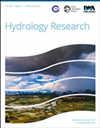衬砌灌溉渠道水力效率评价——以巴基斯坦旁遮普为例
IF 2.4
4区 环境科学与生态学
Q2 Environmental Science
引用次数: 0
摘要
巴基斯坦的印度河流域灌溉系统(IBIS)是该国农业的支柱。IBIS为全国各地的农田提供灌溉支持;然而,由于渗流损失,输水系统的水力效率受到影响。灌溉渠道衬砌被认为是提高水力效率的潜在解决方案。因此,本研究探讨了运河衬砌对巴基斯坦旁遮普省运河水力效率的影响。总体而言,对不同灌溉区的14条河道/支流/支流(总长226公里)的水力性能进行了监测。对河道/分流河道/未成年人的水力、几何和社会经济参数进行了实验观测,包括粗糙度系数、沉积物、流速、湿润周长、决口、盗窃情况、河床、边坡、水面剖面、水力半径、作物产量和植被生长面积。将所得结果与设计和衬砌前的数据进行了比较。采用流入-流出法进行了10次渗流试验,采用积水法进行了8次渗流试验以估算渗流损失。结果表明,几乎所有的参数都与设计值不同。对社会经济参数进行了详细比较。渗透试验的报告结果表明,损失减少了约78%。本文章由计算机程序翻译,如有差异,请以英文原文为准。
Evaluation of hydraulic efficiency of lined irrigation channels – a case study from Punjab, Pakistan
Indus Basin Irrigation System (IBIS) in Pakistan is the backbone of agriculture in the country. The IBIS provides irrigation support to agricultural lands across the country; however, hydraulic efficiency of the water conveyance system is impacted due to seepage losses. The lining of irrigation channels is considered a potential solution for improving hydraulic efficiency. Therefore, this study explores the impact of canal lining on the hydraulic efficiency of the canals in the Punjab province of Pakistan. Overall, 14 channels/distributaries/minors (total length 226 km) were monitored in terms of hydraulic performance in different irrigation zones. The hydraulic, geometrical, and socioeconomic parameters of channel/ distributaries/ minors including roughness coefficient, sediments, flow velocity, wetter perimeter, breaches, theft cases, bed, side slope, water surface profile, hydraulic radius, crop yield, and vegetation growth area have been experimentally observed. The obtained results have been compared with the design and pre-lining data. Ten seepage tests using the inflow–outflow method and eight seepage tests using the ponding method were conducted to estimate seepage losses. Results indicate that almost all the parameters varied from the design values. A detailed comparison of the socioeconomic parameters has been carried out. The reported results from the seepage tests show that approximately 78% reduction in losses.
求助全文
通过发布文献求助,成功后即可免费获取论文全文。
去求助
来源期刊

Hydrology Research
Environmental Science-Water Science and Technology
CiteScore
5.30
自引率
7.40%
发文量
70
审稿时长
17 weeks
期刊介绍:
Hydrology Research provides international coverage on all aspects of hydrology in its widest sense, and welcomes the submission of papers from across the subject. While emphasis is placed on studies of the hydrological cycle, the Journal also covers the physics and chemistry of water. Hydrology Research is intended to be a link between basic hydrological research and the practical application of scientific results within the broad field of water management.
 求助内容:
求助内容: 应助结果提醒方式:
应助结果提醒方式:


